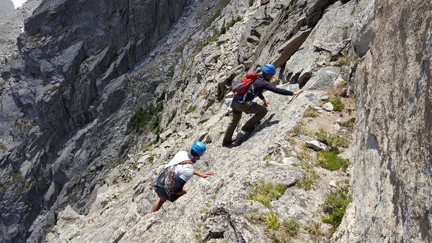 by Garrett Sylvester, Head Coach and Program Director Our beloved Rocky Mountain state has 52 fourtneers (54 depending who you ask) - that's more than fifty 14,000 foot high mountains in Colorado ready to climb, each of which reward you with a kick-ass workout and unforgettable views. Abe Lincoln has a famous quote, "Give me six hours to chop down a tree and I will spend the first four sharpening my axe." That applies perfectly to summiting a mountain. If you decide to climb a fourtneer in Colorado without any physical preparation and knowledge of the weather, gear, and dangers of that specific fourtneer, you can bet that it is going to be rough! Preparing physically, organizing the right gear and learning about the routes and dangers will allow you to conquer the fourtneer with more ease, and come back safely. Here's a brief overview of training you should do to be physically prepared to climb that next mountain.
Before you start any of these exercises, make sure you understand how to do each movement safely. Step Ups Hiking a fourtneer is all up, up, up as you ascend to the top. Loaded step-ups with a backpack or a sandbag will simulate pretty darn close to hiking up a mountain from the comforts of your own gym. Find yourself a step, box, or bench that is anywhere from 12 to 16 inches high, grab yourself a weight (backpack, sandbags, or even a kettle bell) that is roughly 25 for women or 50 pounds for guys and start stepping up and down. This will challenge your quadriceps, core, and endurance when done for high repetitions (one to six hundred). Weighted Walking Lunges Once you get up, you have to be prepared to come down. The decent is even harder on the body than going uphill. Not only are you tired from hiking the way up, the forces placed on the legs are even higher due to absorbing the gravity on the way down. Weighted walking lunges trains your body, specifically the legs and torso, to absorb forces each time you take a step forward. Train these often and your knees will thank you at the end of the long hike. Turkish Get Ups You will hear kettlebell fans call the Turkish Get Up "weighted yoga." This movement improves stability in the shoulders and knees in different angles. When done properly, it will improve your hip and shoulder mobility. The bonus of all this is your torso will be stronger in different positions. Trunk muscles are challenged not only in front and back, get hit hard from the sides. Turkish Get Ups will prepare your trunk and hips will better handle the unpredictable motions of uneven rocky terrain that fourtneers provide. Farmer's Carry Nothing trains the entire body like carrying heavy objects individually in each hand. This movement is king when it comes to training the legs and torso. The weight is constantly pulling you in all directions as there are individual weights in each hand. Your job is to stay tall and upright to fight the weight as you carry it forward. Your forearms are going to burn when done with heavy weight. With this exercise, you're after time under tension. Incorporate these into your training and your backpack will feel light as a feather. Push Ups/ Dips While fourtneers are predominately a leg and core activity, there will be some rugged parts where you will step and push yourself up onto something like big rocks that you encounter on the more difficult mountains. In these moments you'll be glad you practiced push ups. This movement can also help you catch a fall if you were to trip on a rock ( I can speak from personal experience) that otherwise could of knocked your teeth out. Pull Ups/ Rock Climbing This goes hand-in-hand with push ups. On the more rugged fourtneers (routes that have grade three to five ratings), there are parts where you will be required to scramble and even climb to reach to the summit. Being able to pull your body weight up will greatly improve your confidence when the terrain gets more vertical. Train as many different ways as possible by mixing up the grip, using different holds, and loading to one side more than the other. Rock climbing is even better if you have access to a rock climbing gym. Hill Sprints Sprinting is one of the most primitive things we can do as human beings. It was something that was required for us to survive (think running from grizzlies). Now it is often something we rarely do, but should. It is one of the best ways to increase max lung capacity, achieve longer lower intensity endurance, and increase your overall aerobic and anaerobic capacity. Going uphill makes it a self limiting exercise; you will absorb less force than you would on flat land, which is a great finisher because you are less likely to hurt yourself. If you have not sprinted in a while, start out slowly with lower sets and slower speeds. You will increase your speed over several weeks to full-on sprints. Weighted Crawling Crawling on all fours is a lost movement in this modern age. Crawling in many different ways challenges your body to learn to move with opposite limbs at the same time. This works on the core as well as the shoulders and quads. There are times when the hike gets steep, but not quite steep enough to climb, so it is more efficient to crawl than to hike. The bonus is that this movement is great for neurological training as it challenges both hemispheres due the opposite limbs working together. Train these movements and train them hard and with quality form. You will experience an amazing difference on your next mountaintop. If this is your first one, you will enjoy the heck out of it and feel accomplished when you make it back down to celebrate it with your favorite brew!
0 Comments
Your comment will be posted after it is approved.
Leave a Reply. |
Our JournalOur coaches research and report on all things regarding fitness, adventure and the community within. Categories
All
|
Located in SE Denver1950 S. Quebec St.
Denver, CO 80231 Looking for a gym near Denver? We also serve Glendale, Aurora, Lowry, Virginia Village, Denver Tech Center, Cherry Creek, Indian Creek, Wash Park, Broadway, SOBO, and more.
|
|

 RSS Feed
RSS Feed





